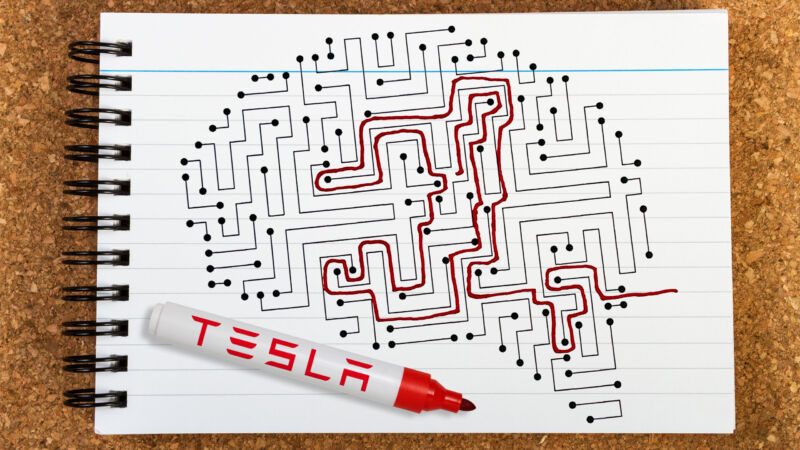
Aurich Lawson | Getty Images
When Tesla recorded its first annual profit in 2020, it had done something fairly remarkable. Starting a new car company has never been easy. It’s harder still when those cars are electric and outside your average buyer’s comfort zone; more than a dozen have tried and failed since Tesla was founded in 2003. Even mighty Apple, with all its billions in the bank, thought better of it. So why, after all that hard work, would Tesla’s CEO now tell everyone that Tesla is an AI company?
The company’s greatest successes have come when it innovates, like when it realized that laptop cells were about energy-dense enough to power a sports car if you just had enough of them. Building out a reliable fast-charging network was another such innovation. But Tesla CEO Elon Musk has also never been afraid to chase a trend, and the hype du jour is artificial intelligence, a field that attracted more than $67 billion in investment last year.
“We are an AI, robotics company; if you value us otherwise, the right answer is impossible to the questions being asked,” Musk told investors and journalists in April.
The company’s profit and loss sheets back that up—Tesla was spending heavily on GPUs from Nvidia rather than on new car lines, although that was followed by news that Musk has had many of those GPUs redirected to his social media company X. And over the past few years, we’ve seen more demonstrations of humanoid robots—with varying degrees of verisimilitude—than new cars.
That lack of attention to the company’s core business is starting to become evident. Tesla’s product lineup is small and increasingly elderly, with the exception of a niche pickup truck that is only road-legal in North America. Price cuts haven’t stopped sales from declining, and the company’s profits are shrinking quarter by quarter.
In the corners of the Internet where people argue about such things, it’s common to see appeals to the investors. Surely they can rein Musk in, get him to focus. Or maybe even replace him. That makes sense if the goal is to end up with a stable automaker that ticks along at a regular cadence. But those kinds of car companies just don’t generate wild profit margins or solar system-sized valuations.
Tesla is currently valued at $661.5 billion, with a price-to-earnings ratio of 58.9. General Motors, by contrast, is valued at $47.9 billion with a price-to-earnings ratio of 4.7.
Are robotaxis really an untapped goldmine?
The company’s spike in valuation presupposes that a successful robotaxi business will generate profits with almost no overheads. But that supposition is unlikely to be correct. “Yes, you’re taking the driver out of the equation in terms of paying a driver, but you’ve added a whole bunch of new costs, especially when you look at the mid-2010s,” said Sam Abuelsamid, principal analyst of transportation and mobility at Guidehouse Insights. “We had Uber and Lyft and others saying, ‘Oh, we’re gonna replace our human drivers with robotaxis, and all of a sudden—multitrillion dollar profits.’ And that was never a viable idea.”
“Even with an asset-light model, they still couldn’t make money. And now you’ve got to build or buy hundreds of thousands or millions of vehicles,” Abuelsamid said. These vehicles need to be maintained and charged or fueled, cleaned, insured, and parked when not in use, and so on. On top of that, “you’ve also got to develop the platform. And this is why Uber, Lyft, and others pulled out and sold that stuff off to others to let them do it,” Abuelsamid told Ars.
Almost all the companies developing autonomous vehicles are going about it in a particular way. “The companies who are all claiming they’re going to design (if not build) vehicles own the platform that you have to use for the point of sale, develop the software, and often develop hardware or modify existing hardware. So that’s the most expensive way to do that,” explained Alex Roy, investor and former director of special operations at Argo AI.
That puts those companies in a race to start generating profits before their investment money is spent. “The other camp is Tesla and Mobileye. They pay for their R&D out of profits for things they sell today. That’s the roadmap there,” Roy said. “Now, Elon has made claims that the data aggregation for the vehicles has portability to other embodied AI, specifically humanoids. And undoubtedly, there is some portability. How much portability? We don’t know,” Roy said.

